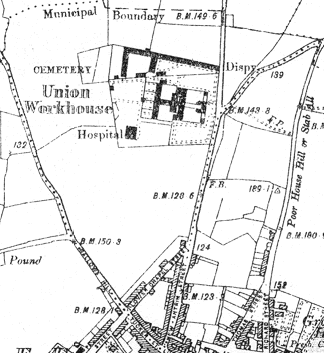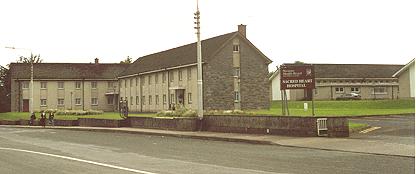Castlebar, Co. Mayo
Castlebar Poor Law Union was formed 18th November 1839 and covered an area of 232 square miles. Its operation was overseen by an elected Board of Guardians, 21 in number, representing its 10 electoral divisions as listed below (figures in brackets indicate numbers of Guardians if more than one):
Co. Mayo:
Addergoole (3), Balla, Ballintubber (3), Ballyhean, Breafy, Castlebar (4), Drum (2), Islandady, Strade (3), Turlough (2).
The Board also included 7 ex-officio Guardians, making a total of 28.
The population falling within the union at the 1831 census had been 58,001 ranging from Breafy (population 2,315) to Castlebar itself (12,111).
The new workhouse, built in 1840-42, occupied a 7-acre site to the north of the town. It was designed to hold 700 inmates and its construction cost £6,300 plus £1,259 for fixtures and fittings etc. It was declared fit for the admission of paupers on 1st August 1842 and admitted its first inmates almost three months later on 22nd October 1842.
The building was constructed to one of George Wilkinson's standard designs with an entrance block at the east containing a board-room, offices etc. Behind this stood the large main block, with women's accommodation to one side and men's to the other. At the rear were wash-rooms, kitchens, store rooms and so on. To the south-west of the main workhouse buildings stood a small fever hospital block, and a cemetery lay adjacent to the site at the north-west. The site layout can be seen on an early Ordnance Survey map:

Castlebar workhouse site.
In common with other unions in Ireland, Ballinrobe suffered greatly during the famine years 1845-50. British Parliamentary Papers for 1847 include this local report of the state of Castlebar workhouse:
|
Mr. Gibbons to Mr. Redington Castlebar, January 8,1847. I beg leave most respectfully to submit, for the consideration of the Lord-Lieutenant, the state of the poor-house of this Union. It is, unhappily, too well known by the reports of local journals transcribed into the public papers, that the house is closed against the admission of paupers during the present trying visitation on the poor, but the condition of those confined in the house, upwards of 100, is not generally known. I am a frequent visitor of the workhouse; after inspecting each class of the inmates, and I am pained to have to state that almost every individual of the 100 or more are showing striking signs of haggard and famished looks; the provisions, oaten or Indian meal, is supplied very irregularly, often not sent to the house until an advanced hour of the day, in quantities of 200 lbs. or so, but never in a large or satisfactory supply. Turf is most irregularly supplied; on many days not all sent, the cause of having the breakfast meal deferred to one or two o'clock, p.m. On New Year's Day the paupers had only one diet, and that at a late hour. The master states that he is obliged to permit the paupers to continue in their beds for heat's sake. The hospital is occupied by the old men, and the children pining away by hunger and cold. Coffins with difficulty procured for those who die. They are prevented by their sufferings from attending the instructions they would otherwise receive from an excellent master, and an equally competent schoolmistress. I beg to pray that his Excellency be assured that I do not exaggerate the deplorable state of this district, Castlebar Workhouse, and that rather, perhaps, I have to blame myself that I did not make this communication to you, Sir, earlier. I had thought the Poor Law Commissioners might have secured the good treatment of the few confined in the house, though they could not compel or enforce the admission of others; the contrary is almost the case; those who are able to creep are preferring to brave want abroad to dying by cold and hunger inside. I again take leave to pray that this lamentable, but true state of the poor-house, Castlebar Union district, be submitted to the Lord Lieutenant. |
The original workhouse buildings have been demolished and the Sacred Heart Hospital now occupies the site.

Castlebar former workhouse site, 2000.
© Peter Higginbotham.
Records
Note: many repositories impose a closure period of up to 100 years for records identifying individuals. Before travelling a long distance, always check that the records you want to consult will be available.
- Local History Department, Castlebar Central Library, Castlebar, Co Mayo.
- London School of Economics Library, Archives Division, Lionel Robbins Building, 10 Portugal Street, London WC2A 2HD. Holds Board of Guardians minute book 1845-47.
Bibliography
- The Famine in Mayo 1845-1850 compiled and edited by Ivor Hamrock. Mayo County Council, 1998.
Links
- None.
Unless otherwise indicated, this page () is copyright Peter Higginbotham. Contents may not be reproduced without permission.


